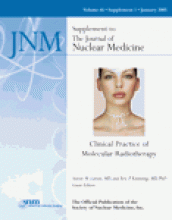Abstract
The challenge for internal therapy is to deliver the highest possible dose to the tumor while sparing normal organs from damage. Currently, the potential risk of kidney and red marrow toxicity limits the amount of radioactivity that may be administered. An accurate dosimetry method that would provide reliable dose estimates to these critical organs and to tumors before therapy would allow the clinician to plan a specific therapeutic regimen and also select those patients who would benefit the most from treatment. The dosimetry for 90Y-1,4,7,10-tetraazacyclododecane-N,N′,N″,N‴-tetraacetic acid-d-Phe1-Tyr3-octreotide is usually based on quantitative imaging at different time points that provides information on activity retention in organs over time and on stylized models representing average individuals. Because the therapeutic agent labeled with 90Y is not suitable for quantitative imaging, the peptide surrogate labeled with the positron emitter 86Y can be considered the most appropriate tracer for measuring distribution and retention of the radiopharmaceutical over time. Dose calculations in target organs are generally performed using the MIRDOSE program, in which S values from source to target are integrated. Significant improvement of dose estimates may be achieved by introducing patient-specific adjustments to the standard models. The use of individual kidney volumes assessed by CT instead of the use of a fixed volume for males and females may significantly improve the determination of kidney radiation doses. The use of actual CT-derived tumor volumes has also shown a dose–efficacy relationship. Additional improvements in this field include the validation and use of an 111In surrogate to avoid the complexity of 86Y use and the consideration of radiobiologic parameters, such as fractionation effects and the specific biologic efficacy of internally deposited radiation, which are probably underestimated using currently available methods.
Footnotes
Received May 19, 2004; revision accepted Sept. 13, 2004.
For correspondence or reprints contact: Stanislas Pauwels, MD, PhD, Centre de Médecine Nucléaire, Université Catholique de Louvain, UCL 54.30, Avenue Hippocrate, 54, B-1200 Brussels, Belgium.
E-mail: stanislas.pauwels{at}mnuc.ucl.ac.be







